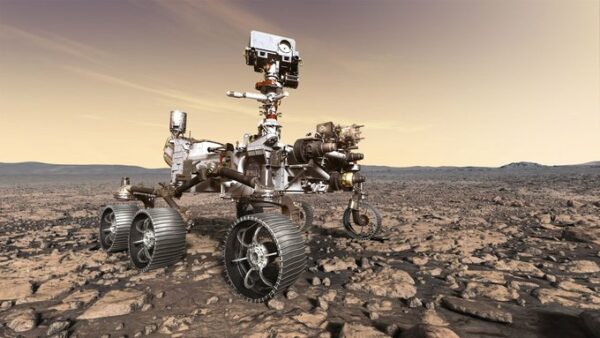
NASA has unveiled stunning videos of its Perseverance rover landing on Mars.
The videos cover the final minutes of last week’s hair-raising descent, up to the point where the rover’s wheels make contact with the ground.
The sequences show a whirl of dust and grit being kicked up as the vehicle is lowered by its rocket backpack to the floor of Jezero Crater.
Perseverance was sent to Mars festooned with cameras, seven of which were dedicated to recording the landing.
Their imagery represents vital feedback for engineers as they look to improve still further the technologies used to put probes on the surface of the Red planet.
All the cameras employed in the descent and landing were off-the-shelf, ruggedized sports cameras, with next-to-no modifications.
The cameras were positioned to capture key hardware events – from the release of the supersonic parachute, through the jettisoning of the entry capsule’s heatshield and flight of the backpack, or “sky crane”, all the way through to touchdown and the backpack’s disposal.
This corresponded to roughly the final four minutes of the rover’s seven-minute descent to the surface.
One of the three cameras looking up at the parachutes failed, but the other six cameras worked flawlessly. NASA had hoped also to record the sound of the descent with a microphone, but unfortunately this didn’t succeed.
However, the team has managed to get a mic operating on the ground so there is the possibility of hearing Perseverance go about its exploration duties in the coming weeks. Already, the muffled sound of the wind in Jezero Crater has been played back.
Videos have been made at Mars before, but these were low frame-rate affairs – more what you might call “stop motion” action. The Perseverance offering on the other hand is simply jaw-dropping in its clarity and detail.
At the weekend, Perseverance’s navigation mast, which had been stowed flat since leaving Earth last year, was raised into the vertical.
This allowed the main science cameras at the mast’s top, the Mastcam-Z system, to begin building a panorama of the surrounding terrain in Jezero and of the deck of the rover itself. The latter mosaic is wanted to look for any damage that might have been inflicted by flying stones at the time of landing.
NASA’s Perseverance Rover Successfully Lands on Mars
Controllers will this week perform the critical task of transitioning Perseverance away from the software that got it safely down to the surface of Mars to one that enables the robot to rove and use equipment such as its robotic arm.
This is likely to take four Martian days, or Sols (a Martian day lasts 24 hours and 39 minutes). We might see a wheel wiggle and the first test drive of a few meters come the weekend.
A NASA satellite, the Mars Reconnaissance Orbiter, has already identified and photographed the discarded hardware from landing.
Perseverance’s landing spot is in a 1.2km by 1.2km quadrangle that the science team has informally called Canyon de Chelly after the National Monument in Arizona.
